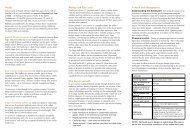Bushland Weeds Manual - Environmental Weeds Action Network
Bushland Weeds Manual - Environmental Weeds Action Network
Bushland Weeds Manual - Environmental Weeds Action Network
You also want an ePaper? Increase the reach of your titles
YUMPU automatically turns print PDFs into web optimized ePapers that Google loves.
80<br />
Chapter 6 Trees, Shrubs and Climbers<br />
Drill and fill: Holes 8-10 mm in diameter are drilled<br />
down at an angle into the sapwood around the base of<br />
the tree at 50-100 mm intervals, ensuring there is an<br />
injection point below each major branch. Inject<br />
approximately 5 mL of herbicide solution into the<br />
holes immediately after drilling each one. The hole<br />
depth will depend on the wood anatomy of the tree<br />
and thickness of the bark, but 30-50 mm is usually<br />
appropriate. A cordless drill or brace and bit can be<br />
used for drilling and the herbicide injected from a<br />
squirt bottle, large syringe or a drench gun.<br />
Alternatively, Sidewinder Tree Injectors ® have been<br />
specifically designed for this task.<br />
Note: Common practice is to inject undiluted herbicide. While this is<br />
sometimes necessary, in other situations a 50 % or even 20 % solution<br />
is adequate.<br />
Frilling: Herbicide can also be injected into the<br />
sapwood by means of frilling. An axe is used to make<br />
cuts into the sapwood around the base of the tree. The<br />
cuts should be 30-50 mm wide by 20-30 mm deep<br />
(ensure cuts penetrate into the sapwood). Herbicide<br />
should be injected immediately into the cuts.<br />
Basal bark<br />
Basal bark treatment is useful on small stems – less<br />
than 20 cm in diameter and some larger trees with thin<br />
bark. The lower 60 cm of bark is<br />
painted or sprayed until<br />
dripping, with a<br />
herbicide and bark<br />
penetrant solution. The<br />
bark penetrant (usually<br />
diesel) carries the<br />
herbicide through thin bark<br />
and into the sapwood. Bark<br />
thickness and characteristics<br />
can influence effectiveness of this<br />
technique. Bark should also be<br />
dry and relatively dirt free. This<br />
method is quicker than<br />
injection or cut and paint, distributes the herbicide<br />
evenly around the tree base and thus evenly into the<br />
sapwood and is useful in tangled thickets.<br />
Treating climbers and brambles<br />
Climbers present their own set of problems when it<br />
comes to control. They scramble over and through<br />
native vegetation making targeted spraying of foliage<br />
difficult. Climbers often have thin stems that cannot be<br />
injected, and when cut off at the base provide an<br />
inadequate surface area for herbicide uptake. They<br />
may also have the ability to sucker and/or stem layer,<br />
putting down roots from the stem into the ground and<br />
trunks or branches of other plants (Morning Glory<br />
(introduced Ipomoea spp), Japanese Honeysuckle<br />
(Lonicera japonica)). For these species, cutting off<br />
stems at the base only cuts one part of the nutrient<br />
supply and is ineffective. Many climbing species<br />
including Dolichos Pea (Dipogon lignosus), Morning<br />
Glory and Madeira Vine, have a large woody or<br />
tuberous root stock and techniques are required that<br />
introduce enough herbicide into the plant to kill it.<br />
Scrape and paint<br />
An effective way of killing<br />
climbers that sucker or stem<br />
layer, is to scrape the stems<br />
with a knife and<br />
immediately paint the<br />
exposed wood with a<br />
systemic herbicide.<br />
This method<br />
increases the surface<br />
area available for<br />
herbicide uptake and<br />
allows the herbicide to<br />
be translocated throughout the<br />
plant – including into secondary<br />
root systems. One or two long<br />
scrapes (300 mm) should be made<br />
along the same side close to the<br />
base of each stem. The scrapes<br />
should be deep enough to expose<br />
the sapwood, but not sever the<br />
stem. Treatments should be<br />
carefully monitored and any<br />
resprouts foliar sprayed or<br />
re-scraped and painted<br />
before they become<br />
entangled with native<br />
vegetation. The scrape and paint approach is suitable<br />
for Madeira Vine, which is particularly difficult to<br />
manage. It produces a multitude of both aerial and<br />
underground tubers which break off easily when the<br />
plant is disturbed and readily form new plants. With<br />
the scrape and paint method there is minimal<br />
disturbance to the canopy and aerial tubers will<br />
gradually wither and die on the plant (Muyt 2001).<br />
Remove and bag aerial tubers from the treatment area<br />
prior to scraping.



